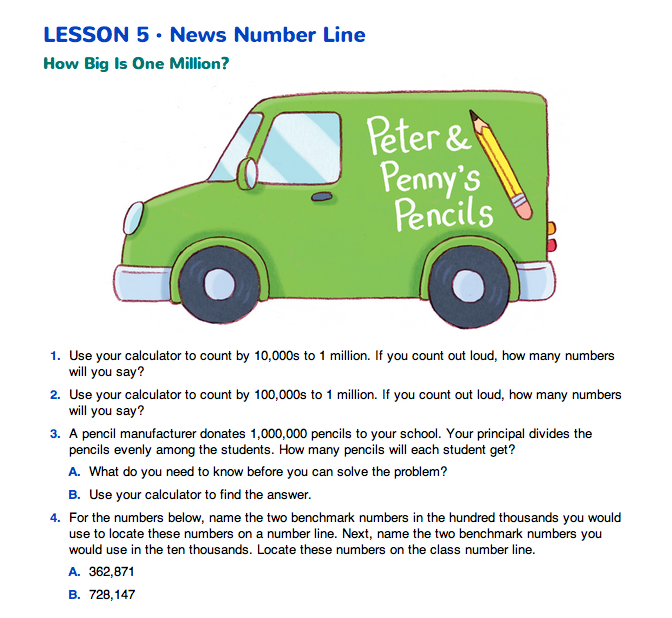News Number Line
Est. Class Sessions: 2Developing the Lesson
Part 2. Use the Number Line Benchmarks
Place Large Numbers on the Number Line. When the number line has been completed, model placing numbers on it. See Sample Dialog 2.
- Read the number.
- Determine and state the 100,000 interval. Name the two benchmarks you will use.
- Determine the 10,000 interval. Name the two benchmarks you will use.
- Explain why you are placing the number in that spot.
Ask student pairs to place one number from the Newswire display on the number line, following the same procedure. Use only numbers less than one million. Have students place additional numbers on the number line, as time allows.
Explore Numbers Greater than One Million. Discuss extending the number line to place numbers greater than 1 million. To continue the proportional model, 10 metersticks would be needed to represent each additional million. Ask the following questions to help students develop a clearer sense of the relative sizes of numbers.
Ask:
Count to One Million. Ask students to turn to the News Number Line pages in the Student Guide. Questions 1–2 ask students to skip count by 10,000s and 100,000s to 1 million using a calculator. See the TIMS Tip.
Question 3 asks students to use a calculator to find the number of pencils each student would get if they divided 1 million pencils equally among all the students in the school. They will need to know the number of students in the school to answer the question.
In Unit 3, students used their calculators to determine if a number is a factor of another number by checking to see if it would divide evenly into the number; that is, if the answer is a whole number. Depending on the number of students in your school, a million pencils may not be divided evenly. In interpreting their answers, remind students that numbers to the right of the decimal point mean that the number will not come out evenly and there will be some pencils left over.
Question 4 provides additional opportunities for students to demonstrate using benchmark numbers to locate numbers on the number line.
















 on many four-function calculators will continuously add 10,000. You may need to test the calculators used in your classroom before presenting this to students. If it does not work, consult the manual that came with your particular model of calculator to find the correct sequence of keystrokes to use a constant. Many scientific calculators have a constant,
on many four-function calculators will continuously add 10,000. You may need to test the calculators used in your classroom before presenting this to students. If it does not work, consult the manual that came with your particular model of calculator to find the correct sequence of keystrokes to use a constant. Many scientific calculators have a constant,  , function.
, function.